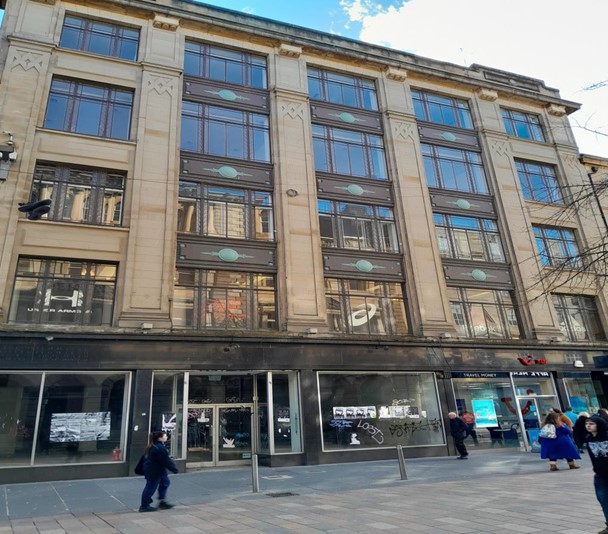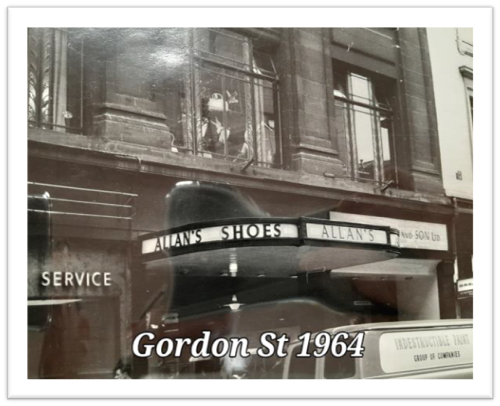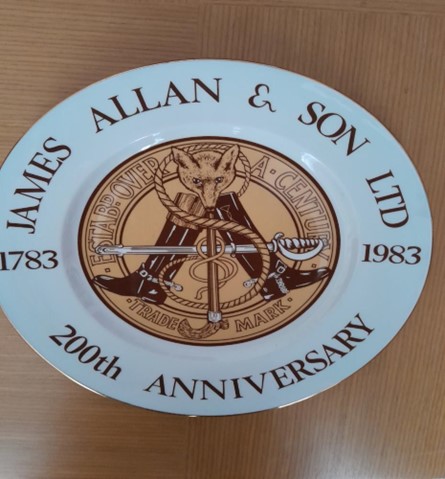James Allan & Son Ltd
by David Doren
James Allan & Son was situated on the ground and first floor of the building shown in the picture below, 19-21 Gordon Street, Glasgow. There is not much in the way of information or records on this building other than what is accessible through archive material in the Mitchell Library, which consists of two pictures from 1964, and architectural plans from 1933 of the building and subsequent alterations over the years thereafter.

Originally, the building was fitted out as one large eatery, with a tearoom on the ground and first floor, a lunchroom on the second, a restaurant on the third, and staff rooms on the fourth. The ground floor shop units consisted of James Allan Shoes, where TUI travel agent is today, Thomas Cook Travel agency and another shop next to the lane. The restaurant is no longer there and the upper floors became various office suites, with James Allan taking over the front of the first floor, a hairdresser to the rear of the first floor, a solicitor’s office on the second, and an oil company on the fourth. Thomas Cook expanded the front of their premises by extending into the shop next to the lane, creating the design as it is seen today.
I worked in James Allan & Son Ltd from the late 1970s till the mid-1980s, and I was the youngest member of full-time staff there at twenty years old, until a temporary trainee window dresser started, and she was seventeen. She started working at the shop on a nine- month contract, to cover for the current window dresser, who was going on maternity leave. she was later kept on as a window dresser. I was tasked with the job of being the ‘Base Trimmer’, which meant I could remove and/or replace shoes from the displays, but not change the design of the window display.
When I started at Allan’s, it was called ‘James Allan & Son Ltd’ after the son joined the family business and eventually, took over from his father. Allan’s as it became affectionately known, was an impressive shop, because it had retained many of the old fittings and features from when the building was the tearooms and restaurant. The display windows were framed in brass with marble tiles making up the floor and frontage of the of the building. The entrance to Allan’s was long and narrow and had a canopy over the entrance area leading into the shop. You entered the shop, through two glass doors, and the first thing on the right side, which caught your eye was, the Art Deco designed and brass fronted lift, with its ornate dial at the top, denoting which floor the lift was on. Next to it was a door leading to a stairwell, taking you down to the basement, there was also a hatch leading into the display window containing ladies' shoes. In the basement, was another lift frontage covered in brass and the original public toilets for the customers of the tearoom, but now used for storing excess stock and boxes of for the shoes in the windows. On the other side of the lift at ground level, there was another set of stairs leading up to the first floor.
The men's shoe department was on the ground floor, and the original floor to ceiling, oak panelled wall coverings were still visible on two walls, and the other two sides were just hidden by the shelving units for the shoe boxes. The shelves were very sturdy, free-standing units and were not attached to any of the wall panels. We would have students come in from the Art School to admire and view the lift. It would be interesting to know if any of their drawings or pictures still survive today in their portfolios. Some of the shop's customers would also comment on ‘If the shop ever decided to remove the panels. To give them a call, and they would make a cash offer on them.’
During my time there, I heard the story of the ‘Grey Lady.’ The story went that, a female member of the restaurant staff had died after being pushed down the stairs, and her ghost was said to haunt the basement and the stairwell. Those who saw the ghost, referred to seeing a woman dressed in a waitress’s uniform which, appeared grey in colour, which is why she is called the ‘Grey Lady.’ In all the time I worked there, I never saw the ghost, but when I went to the TUI travel agents, to enquire about taking a picture of the lift for this story. A young member of the TUI staff asked, “If I knew anything about the ghost.” I never imagined anyone else knew of the ghost, as I must be one of the last surviving members of staff, who knew of the ghost. I was a little taken aback then I asked, “Are you referring to the Grey Lady,” they were visibly shaken and said, “they had seen the ghost.” I had always believed it to be a tall story, but there must be some truth in it, after all.

19-21 Gordon Street, Glasgow. Pictures Circa 1964, courtesy of Glasgow City Archives at the Mitchell Library.
Allan’s was a well-known shoe shop in the city and its clientele was wide and varied. From the great and the good in and around Glasgow to those who wanted a brand of shoe known for its quality and craftmanship (Barker, Church, Grenson, Loake, Bally, Clark’s, Start-Rite). Allan’s was a bit like ‘Grace Brothers,’ of ‘Are You Being Served’ fame, the early 1970’s sitcom with its old traditional style of service. The floor manager was your “Captain Peacock,” while everyone else was your “Mrs Slocombe, Ms Brahm's, Mr Grainger, Mr Lucas. Mr Campbell was the assistant manager of the shop, and the manager of the men’s shoe department. He would stand at the entrance to the men’s shoe department, and would ask the customers which department they required, and he would indicate or direct them to either the lift or the stairs leading to the upper floor. If it were for men’s shoes, he would escort them into the department and call for one of us (assistants) by name, ‘Mr or Mrs such & such.’ to attend to the customer, as it was all very formal. You were never called by your first name in front of customers, and the dress code for the staff reflected this formal look, with the men wearing two/three-piece dark coloured suits and the women, company uniforms (dresses). The only staff this did not apply to was, the maintenance worker, office staff (cashiers, bookkeeper, PA) and the manager of the shop.
Allan’s had several celebrity customers throughout its history Lulu, Christian, Fran & Anna, Rikki Fulton, Cliff Richard, Billy Connelly, MPs, and Councillors. On one occasion, the entrance to the shop played host to some of the cast of the sitcom, “City Lights,” Gerard Kelly, Elaine C Smith, Andy Gray, Tony Roper, and Iain McColl, as they sheltered from the weather, underneath the shops canopy while they filmed some scenes in Gordon Street, the adjacent lane, and Buchanan Street.

Every year, the shop would hold an event to show off the new lines in shoes for that season, and most of the branches of Allan’s would attend. Models would be brought in for the night, to model the latest shoe collections on a catwalk made for the show, on the first floor of the shop. Mr Campbell, Mr McGlashan, and I would model the men's collections 1983 saw the 200th anniversary of James Allan & Son Ltd, including its previous trading names of Allan’s Shoes, James Allan Shoes. All the staff received a special limited addition commemorative plate to mark this achievement. I have included a picture of the plate, which I still have to this day, and it brings back fond memories of working at James Allan’s, the staff, and its customers.
In the mid-1980s, James Allan & Son Ltd went into liquidation, as the son had squandered the money from the business, living the high life and taking expensive holidays abroad with friends which he paid for himself, instead of attending to the business. His sister and the other board of directors took the decision to wind the company up.
I can still remember my work colleagues from the Men’s department of Mrs. Sara Devon, Mr. Hugh Campbell, Mr, and Mr. McGlashan. The window dressers Mr. James Gibson and Ms. Danielle (Danni) Buchan. The Woman’s and children’s department Mrs. Margaret Campbell and Mrs Lindsay. My old manager from my day working in SAXONE Victoria Road, Mrs. Young. The staff was made up of people from diverse backgrounds and lived in different areas around the city and further afield Govanhill, Queen’s Park, Baillieston, Saracen, Maryhill, Coatbridge, Milton, Milngavie, Bridge of Weir, Cumbernauld.





